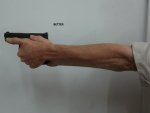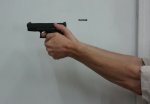So,
Here is the deal: After 20 years of shooting 1911's almost exclusively, I got a G-17 gen 4 for my 40th birthday. (Thank you wifey ). Now I am impressed with the function of the gun and it has obvious good accuracy. However, my precision when shooting the gun seems jinxed. I can shoot quite satisfactory groups with it at 15 yards (about 2-3 inches in diameter), however the groups are consistantly left a couple inches and a couple inches high, no matter what I try. Dry firing yields no obvious large flaw in my pull, other than an ever so slight movement right upon the break. One handed shooting is a little worse high and left. Now the clincher is when shooting from a table/bench at 100 yards using a 2 hand grip and bags/rest, the pistol seems to be pretty well zero'd in. Has my 2 decades of 1911's left me unable to shoot a glock on the principal(J/K), or what am I probably fouling up here?(cant we all get along?) Should my grip be different on the glock? (By the way, I tried both the M backstrap and the bare gun with about equal results. My hands are not big enough for large grips.) I usually shoot left hand below and thumbs pressed together up to get a quick locked grip without hitting my 1911 safety or slide stop(an old Rob Leatham method). I notice when rapidly firing the gun I get groups more around the center of the target if this helps any. It seems the harder I try to shoot it accurately and slowly, the worse off high and left I get. Suggestions on corrections to try would be appreciated. I do not wish to adjust the sights when I know they appear to be aligned right when the gun is benched.
). Now I am impressed with the function of the gun and it has obvious good accuracy. However, my precision when shooting the gun seems jinxed. I can shoot quite satisfactory groups with it at 15 yards (about 2-3 inches in diameter), however the groups are consistantly left a couple inches and a couple inches high, no matter what I try. Dry firing yields no obvious large flaw in my pull, other than an ever so slight movement right upon the break. One handed shooting is a little worse high and left. Now the clincher is when shooting from a table/bench at 100 yards using a 2 hand grip and bags/rest, the pistol seems to be pretty well zero'd in. Has my 2 decades of 1911's left me unable to shoot a glock on the principal(J/K), or what am I probably fouling up here?(cant we all get along?) Should my grip be different on the glock? (By the way, I tried both the M backstrap and the bare gun with about equal results. My hands are not big enough for large grips.) I usually shoot left hand below and thumbs pressed together up to get a quick locked grip without hitting my 1911 safety or slide stop(an old Rob Leatham method). I notice when rapidly firing the gun I get groups more around the center of the target if this helps any. It seems the harder I try to shoot it accurately and slowly, the worse off high and left I get. Suggestions on corrections to try would be appreciated. I do not wish to adjust the sights when I know they appear to be aligned right when the gun is benched.
Thanks in advance for the help.
Here is the deal: After 20 years of shooting 1911's almost exclusively, I got a G-17 gen 4 for my 40th birthday. (Thank you wifey
Thanks in advance for the help.




